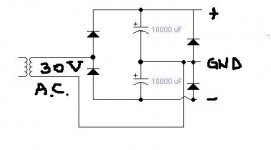Is this an attempt to obtain a split rail supply from a single secondary?
Ripple performance at least would be terrible since the capacitors are charged alternately, can't see any merit in this design at all
Ripple performance at least would be terrible since the capacitors are charged alternately, can't see any merit in this design at all

I've tried it from time to time with a 50VA or so EI core transformer to power a symmetric regulable power supply, until I got the rignt transformer
The result was normal as long as there were little o no imbalance between loads in the +Vout and -Vout
When loads tend to be different the transformer saturated due to asymetric voltage drop in its windings and asymetric Volts*Seconds applied to the core
Saturation will cause excessive transformer heating, excessive and asymmetric current consumption from mains and lots of voltage drop on the outputs
I've not tried it for powering an audio amp
You can try it but you will find its drawbacks soon
The result was normal as long as there were little o no imbalance between loads in the +Vout and -Vout
When loads tend to be different the transformer saturated due to asymetric voltage drop in its windings and asymetric Volts*Seconds applied to the core
Saturation will cause excessive transformer heating, excessive and asymmetric current consumption from mains and lots of voltage drop on the outputs
I've not tried it for powering an audio amp
You can try it but you will find its drawbacks soon
10q I am not going to try it because you were very persuasive...
It was the kind of answer I wanted.
It was the kind of answer I wanted.

full wave voltage doubler
Vout= 30 x 2.8 = 84 or +/-42 volts rails at no load...this should work although regualtion is inferior to that of a 60vct tranffo...
Vout= 30 x 2.8 = 84 or +/-42 volts rails at no load...this should work although regualtion is inferior to that of a 60vct tranffo...
- Status
- Not open for further replies.
